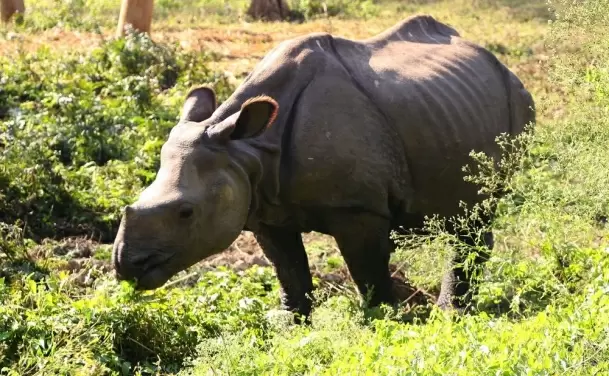Nepal makes progress in conserving forest, wildlife species
Kathmandu
11-October-2021

PHOTO: IANS
Nepal has managed to increase forested areas and the population of endangered animals, tigers and one-horned rhinos in particular, in its efforts to preserve biodiversity over the years, according to the Ministry of Forests and Environment.
A network of 20 protected areas covers nearly 24 per cent of the total forest areas and manages over 243 watersheds, according to the Ministry.
Nepali officials and experts attribute the success mainly to the community-based forest management system.
In 1957, the Nepali government nationalised the privately-owned forest resources and continued to expand governments' role in forest protection and management till early 1970s.
In the late 1970s, a community-based forest management system was introduced, and there are over 22,000 forest user groups now across the country which have been proved to be vital in preserving forest resources.
"The preservation of forest resources under the community-based forest management system, the migration of people from hilly areas to plain areas leaving forests to grow, and the increasing use of cooking gas instead of fire woods have all contributed to the growth of the areas covered by forest," said Prabhu Budhathoki, an expert on biodiversity conservation.
Watch This TWL Video
According to the Forests Ministry, Nepal boasts an ecologically diverse landscape which is home to many different species of flora and fauna. The South Asian country has as many as 35 different vegetation types and 118 ecosystems.
"The community-based forest management system has played an important role not only in expanding the forested areas, but also in preserving biodiversity and wildlife in forests managed by community forestry user groups," said Bharati Kumari Pathak, chairperson of the Federation of Community Forestry Users in Nepal.
She highlighted the preservation of certain species of trees, including Shorea robusta, locally known as Sal, Acacia catechu, locally known as Khair, and Dalbergia, locally known as Sissoo.
For the protection of vulnerable wildlife species, small zoos have been developed inside community forests, she said.
Besides notable progress in forest protection, Nepal has also made efforts in preserving tigers and one-horned rhinos, both endangered species.
When the Nepali government declared in 2018 that the tiger population in the country had reached 235 from 121 in 2009, it put the country ahead of other countries on track to meet the international goal of doubling the tiger population by 2022.
In 2010, Nepal, along with other range countries, endorsed the St. Petersburg Declaration on Tiger Conservation.
Since then, the country has been conducting a four-year periodic assessment to track the progress toward reaching the national target of 250 tigers.
In April this year, Nepal declared that the number of one-horned rhinos had increased to 752 from 645 in 2015.
The Himalayan country is among a few countries where the greater one-horned rhinos are found.
The conservation efforts in both Nepal and India are lauded, as one-horned rhinos were once on the verge of extinction with just 200 living by 1900s, according to the World Wildlife Fund - IANS
More Headlines
Rupee Symbol Debate Heats Up as Tamil Nadu Opts for ‘ரூ’
AIADMK Walks Out, BJP Boycotts Tamil Nadu Budget Session
AI Cybersecurity Startup Neural Defend Raises $600K in Pre-Seed Round
Chennai Doctor and Family Found Dead Amid ₹5 Crore Business Loss
Karnataka Withdraws CID Probe in Ranya Rao Gold Smuggling Case
Rupee Symbol Debate Heats Up as Tamil Nadu Opts for ‘ரூ’
AIADMK Walks Out, BJP Boycotts Tamil Nadu Budget Session
AI Cybersecurity Startup Neural Defend Raises $600K in Pre-Seed Round
Chennai Doctor and Family Found Dead Amid ₹5 Crore Business Loss
Karnataka Withdraws CID Probe in Ranya Rao Gold Smuggling Case










